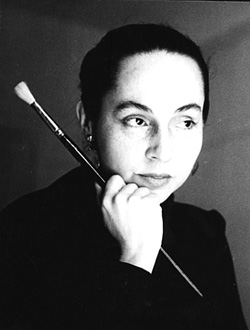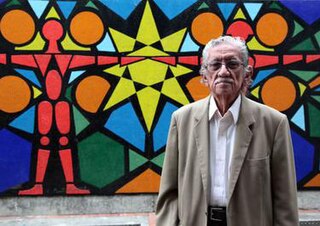Related Research Articles
The music of Ecuador is a diverse aspect of Ecuadorian culture. Ecuadorian music ranges from indigenous styles such as pasillo to Afro-Ecuadorian styles like bomba to modern indie rock like "Cambio de Tonalidad" by Da Pawn.

Alfredo Pareja Diezcanseco — born Alfredo Pareja y Díez Canseco — was a prominent Ecuadorian novelist, essayist, journalist, historian and diplomat. An innovator of the 20th-century Latin American novel, he was a founding member of the literary Grupo de Guayaquil, which brought a new emphasis to realistic novels.

Theo Constanté Parra was a master Latin American painter part of the Abstract Informalist Movement in Ecuador. In 2005, Constanté won the country's most prestigious award for art, literature and culture, the Premio Eugenio Espejo National Award, presented by the President of Ecuador. Constanté's works are abstract in nature and consist of many colors which meld together amongst loosely drawn geometric lines. Constanté stated that his favorite colors were red, orange and blue and they are the colors that are typically more dominant in his work.

Estuardo Maldonado is an Ecuadorian sculptor and painter inspired by the Constructivist movement. Maldonado is a member of VAN, the group of Informalist painters founded by Enrique Tábara. Other members of VAN included, Aníbal Villacís, Luis Molinari, Hugo Cifuentes, León Ricaurte and Gilberto Almeida. Maldonado's international presence is largely due to his participation in over a hundred exhibits outside of Ecuador.

Araceli Gilbert de Blomberg, was an Ecuadorian artist.
Noralma Vera Arrata is a former Ecuadorian prima ballerina and choreographer.

Gilberto Almeida Egas was an Ecuadorian painter born in San Antonio de Ibarra, in Imbabura Province. He studied at the School of Fine Arts in Quito from 1953 to 1957. His early work was in many media, especially paintings of buildings and views in old Quito; his later work concentrated on large black-and-white drawings, in a baroque, expressionistic, and dramatic style.

Rodolfo Pérez Pimentel is an Ecuadorian lawyer, historian, and biographer. He was declared the lifetime chronicler of the city of Guayaquil, and is a member of the National Academy of Ecuadorian History. He was the 2005 recipient of the Premio Eugenio Espejo in Literature, awarded to him by President Alfredo Palacio.

Rafael Díaz Ycaza was an Ecuadorian poet, novelist, short story writer, and columnist for the Ecuadorian newspaper El Universo.
Galo René Pérez Cruz was an Ecuadorian writer, poet, literary critic, biographer, and college teacher.
Antonio Parra Velasco was an Ecuadorian thinker, diplomat, and internationalist.

Jorge Pérez Concha was an Ecuadorian historian, biographer, writer, and diplomat.

Guillermo Ayoví Erazo better known as Papá Roncón was an Afro-Ecuadorian musician, singer, and marimba player.

Jorge Swett Palomeque was an Ecuadorian muralist, painter, lawyer and writer.
Alfredo Palacio Moreno was an Ecuadorian sculptor and painter.

Jorge Núñez Sánchez was an Ecuadorian writer, historian, and professor.
Oswaldo Muñoz Mariño was an Ecuadorian architect and painter.

Tania Tinoco was an Ecuadorian journalist, author, television producer, director, TV and radio presenter, reporter, interviewer, and opinion leader. For more than 30 years she has been known as the host of the Ecuavisa nightly newscast, Televistazo.

Fernando Cazón Vera is an Ecuadorian poet and journalist. He was born in Quito in 1935 but moved as a child to Guayaquil upon the early death of his father in 1941. He was the only child born to German Jan Andries Jolles, a communist activist also known in exile since 1933 as ‘Manuel Enrique Cazón Arribar’, and Ecuadorian Leonor Vera. His father was a son of Nazi Party member André Jolles and his mother a daughter of Alfredo R. Vera Benavides, Chief Public Prosecutor of Guayaquil. He grew-up surrounded by his maternal family, including uncles Pedro Jorge Vera and Alfredo Vera Vera and his cousin, ballet dancer Noralma Vera Arrata.

Patricia Lucía Alexandra González Avellán is an Ecuadorian singer from Guayaquil. In 2022 she was given Ecuador's highest award for culture.
References
- ↑ Lida Esperanza, Carrillo García (2021). Ponencia - Lida Esperanza Carrillo García - Isla Santa Cruz Galápagos, Ecuador - 2016. Universidad Santo Tomás.
- ↑ Complete Spanish Biography of Esperanza Cruz Hidalgo
- ↑ "Esperanza Cruz Hidalgo, 66 Años Viviendo Su Pasion por el Ballet". Archived from the original on 2013-10-30. Retrieved 2013-10-29.
- ↑ La vocación de Esperanza Cruz por la enseñanza de la danza
- ↑ List of winners of the Premio Eugenio Espejo with Spanish biographies Archived October 29, 2013, at the Wayback Machine